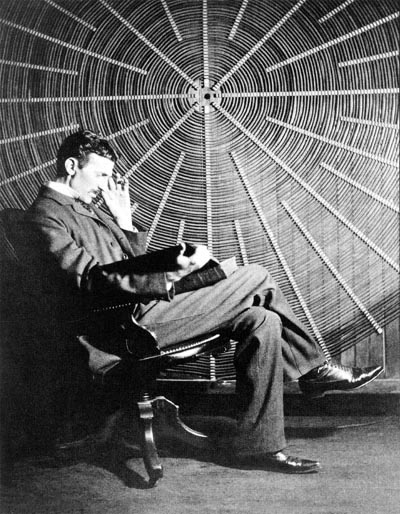The story of Nikola Tesla is one of the great personal tragedies of modern history. Arguably one of the greatest scientific geniuses of all time, Tesla faced poverty, slander and persecution during his lifetime. His numerous inventions and discoveries offered the potential to revolutionize the world, and when and where they were implemented, they did so. But Telsa came into conflict with Thomas Edison, America’s foremost inventor at the time, and Edison’s superior sense of business and advertising destroyed Tesla’s reputation and left him and many of his ideas frustrated and unfulfilled. Thankfully, with the rise of steampunk and a renewed interest in nineteenth century science, Tesla has come back into the public eye and, one hopes, will finally get the recognition he deserves.
Tesla was born in 1856 into a Serbian family living in the Austro-Hungarian Empire. From an early age, Tesla was fascinated with science and endeavored to become an engineer. When he immigrated to the United States in the 1880s, he brought with him an idea for a new and more efficient method of power generation known as Alternating Current (AC). He was introduced to Thomas Edison, then one of America’s most prestigious inventors and the man responsible for the incandescent light bulb being used increasingly throughout the United States. But Edison was not interested in helping Tesla develop Alternating Current, which would have represented a direct challenge to the Direct Current (DC) system of generation already in use by Edison. Instead, Edison hired Tesla to make improvements to the DC generation plants, allegedly offering $50,000 if the seemingly impossible task could be accomplished. When, far from failing, Tesla made an impressive overhaul of the generator design, Edison claimed that the offer of $50,000 had been a joke. Tesla promptly resigned.
Faced with financial hardship, Tesla was eventually reduced to digging ditches for the Edison company. In 1887, Tesla filed patents for his AC power generation technology. Soon after, he joined with industrialist George Westinghouse to try and realize the dream of AC power. Because of AC’s superior qualities, this represented a direct attack on Edison’s DC power. What followed was a competition known as the “War of the Currents.” Edison, already extremely adept at advertising and self-promotion, launched into a vicious propaganda campaign as he tried to brand AC power as inherently dangerous. In addition to his slander, Edison had a man named Professor Harold Brown travel around giving demonstrations of animals being electrocuted with Alternating Current on stage in front of audiences. In 1890, Brown conducted the first electric chair execution, using an AC generator. Efforts were then made to have the technique of electrocution named “Westinghousing.”
In spite of Edison’s horrendous propaganda, in 1893, the Columbian Exhibition (a World’s Fair held in Chicago) was lit by a hundred thousand lamps powered by AC generators. In the end, Tesla and Westinghouse persevered, but the monetary damages imposed by the War of Currents robbed Tesla of his financial security.
The radical development of Alternating Current that set him so at odds with Edison was but one of Tesla’s many scientific accomplishments. Others included the discovery of wireless energy transmission, experiments with long-distance radio, x-ray photography, radio-based remote control, proto-robotics, radar, and even a death ray (which he invented with hope of ending war by making the invasion of a country impossible).
The tragedy of Tesla is profound. He was truly a genius and a visionary, and his death, alone and penniless, is both heartbreaking and unworthy of a man of his accomplishments. It is worth noting that Drunk History has a rather remarkable Tesla episode that, although suffering from the disjointedness and absurdity of any Drunk History episode, is really quite a reasonable summary of Tesla’s story. Be forewarned, however, that it does involve scenes of intoxication and its side effects.
G. D. Falksen feels a deep sympathy for Tesla, and for any artist or inventor who is stifled in spite of dedication and hard work. More information can be found on his Twitter and Facebook.










